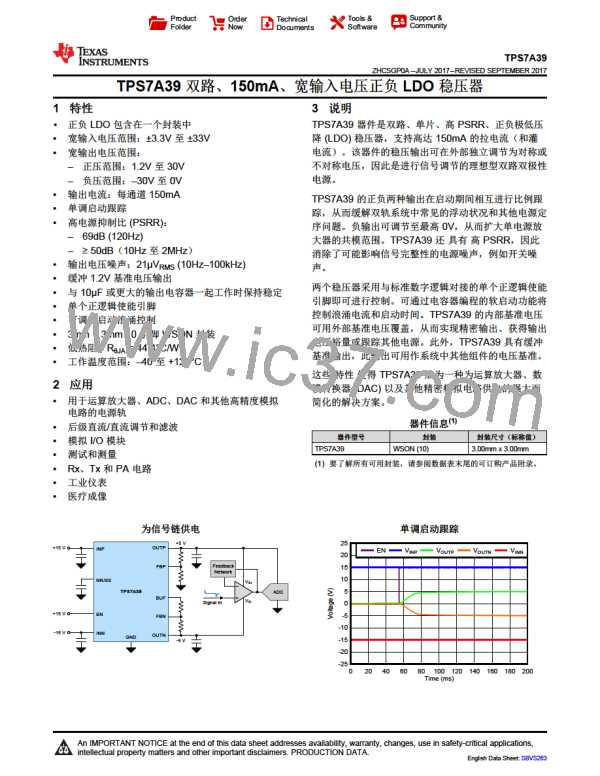TPS7A39
www.ti.com.cn
ZHCSGP0A –JULY 2017–REVISED SEPTEMBER 2017
Regardless of the ceramic capacitor type selected, ceramic capacitance varies with operating voltage and
temperature. As a rule of thumb, derate ceramic capacitors by at least 50%. The input and output capacitors
recommended herein account for an effective capacitance derating of approximately 50%, but at higher VIN and
VOUT conditions (that is, VIN = 5.5 V to VOUT = 5.0 V) the derating can be greater than 50% and must be taken
into consideration.
For high performance applications polymer capacitors are ideal as they do not experience the large deratings of
ceramic capacitors.
8.1.3 Input and Output Capacitor (CINx and COUTx
)
The device is designed and characterized for operation with ceramic capacitors of 10 µF or greater (2.2 µF or
greater of effective capacitance) at each input and output.
Locate the input and output capacitors as near as practical to the respective input and output pins to minimize
the trace inductance from the capacitor to the device. If the LDO is used to produce low output voltages (below
5 V), a 4.7-µF output capacitor can be used. If a 4.7-µF output capacitor is used, be sure to account for the
derating of the capacitors during design.
Large, fast line transients on the input supplies can cause the device output to momentarily turn off. Typically
these transients do not occur in most applications, but when these transients do occur use a larger input
capacitor to slow down the line transient. If the system has input line transients that are faster than 0.5 V/µs,
increase the input capacitance.
8.1.4 Feed-Forward Capacitor (CFFx
)
Although a feed-forward capacitor (CFFx) from the FBx pin to the OUTx pin is not required to achieve stability, a
10-nF external CFFx capacitor optimizes the transient, noise, and PSRR performance. The maximum
recommended value for CFFx is 100 nF.
A larger CFFx can dominate the start-up time set by CNR/SS, for more information see the Pros and Cons of Using
a Feed-Forward Capacitor with a Low Dropout Regulator application report.
8.1.5 Noise-Reduction and Soft-Start Capacitor (CNR/SS
)
Although a noise-reduction and soft-start capacitor (CNR/SS) from the NR/SS pin to GND is not required, CNR/SS is
highly recommended to control the start-up time and reduce the noise-floor of the device. For start-up tracking to
function correctly, a minimum 4.7-nF capacitor is required. As the time constant formed by the feedback resistors
and feed-forward capacitors increases, the value of the CNR/SS capacitor must also be increased for startup
tracking to work correctly. To figure out how to calculate the time constant of the feedback network see the Pros
and Cons of Using a Feed-Forward Capacitor with a Low Dropout Regulator application report.
8.1.6 Buffered Reference Voltage
The voltage at the NR/SS pin, whether driven internally or externally, is buffered with a high-bandwidth, low-noise
op amp. The BUF pin can be used as a voltage reference in many signal chain applications.
8.1.7 Overriding Internal Reference
The internal reference of the LDO can be overridden using an external source to increase the accuracy of the
LDO and lower the output noise. To override the internal reference connect the external source to the NR/SS pin
of the LDO. In order to overdrive the internal reference the external source must be able to source or sink 100 µA
or greater.
The internal reference achieves a 2% accuracy from –40°C to +125°C; using an external reference can help
achieve better accuracy over temperature.
版权 © 2017, Texas Instruments Incorporated
27

 TI [ TEXAS INSTRUMENTS ]
TI [ TEXAS INSTRUMENTS ]